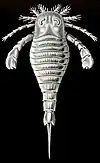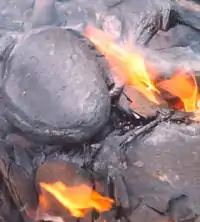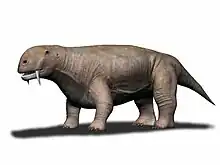The Paleozoic Portal IntroductionThe Paleozoic (IPA: /ˌpæli.əˈzoʊ.ɪk,-i.oʊ-, ˌpeɪ-/ PAL-ee-ə-ZOH-ik, -ee-oh-, PAY-; or Palaeozoic) Era is the first of three geological eras of the Phanerozoic Eon. Beginning 538.8 million years ago (Ma), it succeeds the Neoproterozoic (the last era of the Proterozoic Eon) and ends 251.9 Ma at the start of the Mesozoic Era. The Paleozoic is subdivided into six geologic periods (from oldest to youngest): Some geological timescales divide the Paleozoic informally into early and late sub-eras: the Early Paleozoic consisting of the Cambrian, Ordovician and Silurian; the Late Paleozoic consisting of the Devonian, Carboniferous and Permian. The name Paleozoic was first used by Adam Sedgwick (1785-1873) in 1838 to describe the Cambrian and Ordovician periods. It was redefined by John Phillips (1800–1874) in 1840 to in cover the Cambrian to Permian periods. It is derived from the Greek palaiós (παλαιός, "old") and zōḗ (ζωή, "life") meaning "ancient life". The Paleozoic was a time of dramatic geological, climatic, and evolutionary change. The Cambrian witnessed the most rapid and widespread diversification of life in Earth's history, known as the Cambrian explosion, in which most modern phyla first appeared. Arthropods, molluscs, fish, amphibians, reptiles, and synapsids all evolved during the Paleozoic. Life began in the ocean but eventually transitioned onto land, and by the late Paleozoic, great forests of primitive plants covered the continents, many of which formed the coal beds of Europe and eastern North America. Towards the end of the era, large, sophisticated synapsids and diapsids were dominant and the first modern plants (conifers) appeared. (Full article...) Selected article on the Paleozoic world and its legacies Artist's reconstruction of Waptia fieldensis. Chelicerates were originally predators, but the group has diversified to use all the major feeding strategies. The guts of most modern chelicerates are too narrow for solid food, and they generally liquidize their food by grinding it with their chelicerae and pedipalps and flooding it with digestive enzymes. Most lay eggs that hatch as what look like miniature adults. In most chelicerate species the young have to fend for themselves, but in scorpions and some species of spider the females protect and feed their young. The chelicerata originated as marine animals, possibly in the Cambrian period, but the first confirmed chelicerate fossils, eurypterids, date from 445 million years ago in the Late Ordovician period. The surviving marine species include the four species of xiphosurans (horseshoe crabs), and possibly the 1,300 species of pycnogonids (sea spiders), if the latter are chelicerates. (see more...) Selected article on the Paleozoic in human science, culture and economics Burning oil shale. Heating oil shale to a sufficiently high temperature causes the chemical process of pyrolysis to yield a vapor. Upon cooling the vapor, the liquid shale oil—an unconventional oil—is separated from combustible oil-shale gas (the term shale gas can also refer to gas occurring naturally in shales). Oil shale can also be burned directly in furnaces as a low-grade fuel for power generation and district heating or used as a raw material in chemical and construction-materials processing. Oil-shale mining and processing raise a number of environmental concerns, such as land use, waste disposal, water use, waste-water management, greenhouse-gas emissions and air pollution. Estonia and China have well-established oil shale industries, and Brazil, Germany, and Russia also utilize oil shale. (see more...) Selected image
Did you know? Restoration Tiarajudens.
Need help?Do you have a question about Paleozoic that you can't find the answer to? Consider asking it at the Wikipedia reference desk. TopicsGeochronology - Cambrian (Early - Middle - Late) - Ordovician (Early - Middle - Late) - Silurian (Early - Wenlock - Ludlow - Late) - Devonian (Early - Middle - Late) - Carboniferous (Mississippian - Pennsylvanian)- Permian (Early - Middle - Late) Paleozoic landmasses - Pannotia - Baltica - Laurentia - Siberia - Avalonia -Gondwanaland - Laurentia - Euramerica - Gondwana - South China- Pangaea Major Paleozoic events - Cambrian Explosion - Cambrian substrate revolution - End-Botomian mass extinction - Cambrian–Ordovician extinction event Cambrian biota appearances - Brachiopods - Burgess shale fauna - Cephalopods - Chitons - Crustaceans - Echinoderms - Foraminiferans - Graptolites - Radiolarians -Trilobites - Vertebrates Ordovician biota appearances - Conodonts - Echinoids Silurian biota appearances - Fungi - Galeaspids - Heterostracans - Land plants - Pituriaspids -Ray-finned fishes - Scorpions - Trigonotarbids Devonian biota appearances - Crabs - Ferns - Harvestmen - Lichens - Lycophytes - Mites -Springtails - Stoneworts - Trimerophytes Carboniferous biota appearances - Amphibians - Hagfishes - Insects - Ratfishes - Reptiles -Synapsids Permian biota appearances - Beetles - Pelycosaurs - Temnospondyls - Therapsids Fossil sites - Bear Gulch Limestone - Beecher's Trilobite Bed - Gilboa Forest - Grenfell fossil site - Hamilton Quarry - Mazon Creek fossil beds - Mississippi Petrified Forest - Walcott Quarry - Walcott–Rust quarry - Yea Flora Fossil Site Stratigraphic units - Burgess Shale - Chazy Formation - Columbus Limestone - Fezouata formation - Francis Creek Shale - Gogo Formation - Holston Formation - Hunsrück Slate - Jeffersonville Limestone - Karoo Supergroup - Keyser Formation - Kope Formation - Llewellyn Formation - Mahantango Formation - Maotianshan Shales - Marcellus Formation - Millstone Grit - New Albany Shale - Old Port Formation - Old Red Sandstone - Potsdam Sandstone - Red Beds of Texas and Oklahoma - Rhynie chert - Shawangunk Formation - St. Peter Sandstone - Tuscarora Formation History - History of paleontology - Timeline of paleontology - The Great Devonian Controversy Researchers - Charles Emerson Beecher - Ermine Cowles Case - Edward Drinker Cope - Henry De la Beche - Stephen Jay Gould - Increase A. Lapham - Charles Lapworth - Simon Conway Morris - Roderick Murchison - Alfred Sherwood Romer - Neil Shubin - Charles Doolittle Walcott Culture - Animal Armageddon - The Day The Earth Nearly Died - List of creatures in the Walking with... series - Lost Worlds, Vanished Lives - Miracle Planet - Prehistoric Park - Sea Monsters - Treatise on Invertebrate Paleontology - Vertebrate Paleontology - Walking with Monsters - Wonderful Life Quality ContentFeatured Paleozoic articles - Bone Sharps, Cowboys, and Thunder Lizards - Bone Wars - Edward Drinker Cope - Geology of the Capitol Reef area - Geology of the Death Valley area -Geology of the Grand Canyon area - Geology of the Zion and Kolob canyons area Good Paleozoic articles - Chitinozoan - Coal ball - Dimetrodon - History of paleontology - Evolutionary history of life - Ornatifilum - Opabinia - Paleontology- Schinderhannes - Small shelly fauna - Temnospondyli - Tiktaalik - Waptia Subcategories Paleozoic Paleozoic by continent Paleozoic geochronology Paleozoic geology Paleozoic life Paleozoic paleogeography Paleozoic paleontological sites Paleozoic portals Paleozoic stubs Things you can do
Current Paleozoic FACs - none currently Related contentAssociated WikimediaThe following Wikimedia Foundation sister projects provide more on this subject:
Discover Wikipedia using portals
|

